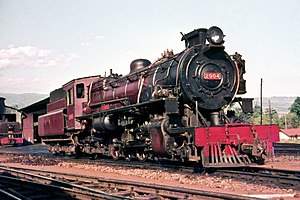From Wikipedia, the free encyclopedia
East African Railways 29 class No. 2904 at
Moshi depot, Tanzania, in 1968
Specifications Configuration: • Whyte 2-8-2 • UIC 1′D1' h2 Gauge 1,000 mm 3 ft 3+ 3 ⁄8 in )Driver dia.48 in (1,219 mm) Adhesive weight 52 long tons (53 t) Loco weight 73.8 long tons (75.0 t) Fuel type Oil Fuel capacity 2,056 imp gal (9,350 L; 2,469 US gal) Water cap. 4,800 imp gal (22,000 L; 5,800 US gal) Firebox: • Grate area 38 sq ft (3.53 m2 ) Boiler pressure 200 psi (1.38 MPa) Heating surface: • Firebox 146 sq ft (13.6 m2 ) • Tubes 1,680 sq ft (156 m2 ) • Total surface 2,272 sq ft (211.1 m2 ) Superheater: • Type Inside • Heating area 446 sq ft (41.4 m2 ) Cylinders 2 Cylinder size 18 in × 26 in (457 mm × 660 mm) Valve gear Walschaerts Loco brake Westinghouse type Train brakes Westinghouse type
The EAR 29 class was a class of oil-burning 1,000 mm 3 ft 3+ 3 ⁄8 in ) gauge 2-8-2 steam locomotives based upon the Nigerian Railways River class . Thirty-one were built for the East African Railways (EAR), in two batches, of 20 and 11, respectively, by North British Locomotive Company in Glasgow , Scotland. They were built to be gauge convertible to 1,067 mm 3 ft 6 in ) gauge.[3]
Class list [ edit ] The numbers, build years and names of each member of the class were as follows:
See also [ edit ] References [ edit ] Bibliography [ edit ]
Durrant, A E; Lewis, C P; Jorgensen, A A (1981). Steam in Africa . London: Hamlyn . ISBN 978-0-600-34946-4 OCLC 9014344 . OL 15088099M . Wikidata Q111363476 . Patience, Kevin (1976), Steam in East Africa: a pictorial history of the railways in East Africa, 1893-1976 , Nairobi: Heinemann Educational Books (E.A.) Ltd, OCLC 3781370 , Wikidata Q111363477 Ramaer, Roel (1974). Steam Locomotives of the East African Railways . David & Charles Locomotive Studies. Newton Abbot, North Pomfret: David & Charles . ISBN 978-0-7153-6437-6 OCLC 832692810 . OL 5110018M . Wikidata Q111363478 . Ramaer, Roel (2009). Gari la Moshi: Steam Locomotives of the East African Railways . Malmö: Stenvalls. ISBN 978-91-7266-172-1 OCLC 502034710 . Wikidata Q111363479 . Staff writer (June 1952). " (PDF) . Staff Magazine . 1 (1). East African Railways and Harbours . Retrieved 8 December 2014 . Staff writer (December 1954). " (PDF) . East African Railways and Harbours Magazine . 1 (11). East African Railways and Harbours : 14. Retrieved 8 December 2014 .
External links [ edit ] EAR 29 class at Wikimedia Commons

![]() Media related to EAR 29 class at Wikimedia Commons
Media related to EAR 29 class at Wikimedia Commons
